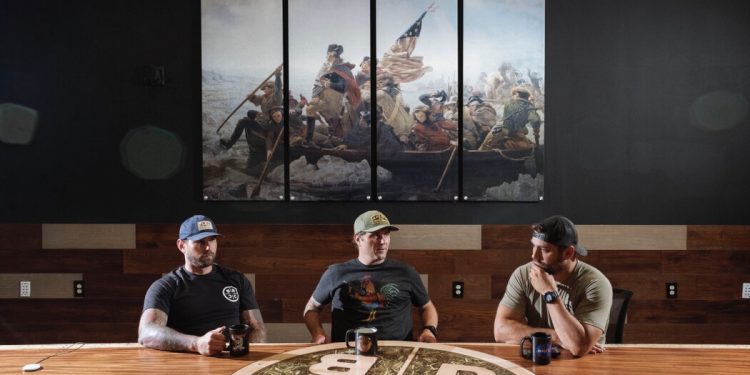Back in the United States, newly remarried and with a baby on the way, Hafer searched for a place in civilian life. He connected with Best, whom he knew from the C.I.A.-contractor world. While still a contractor, Best started making bro-ish videos poking fun at military life — blowing up a giant pink teddy bear with Tannerite, for instance — and posting them to Facebook and YouTube. They caught the eye of Jarred Taylor, an Air Force staff sergeant stationed in El Paso who had a video-production company. Taylor helped Best put out a more polished product, with more guns and more women in bikinis. Before long, Best was an internet celebrity in military circles, with over a million subscribers to his YouTube channel. He and Taylor started a military-themed T-shirt company called Article 15, after the provision in the Uniform Code of Military Justice that governs minor disciplinary matters. Their shirts featured designs like a machine-gun-toting Smokey Bear (“Only You Can Prevent Terrorism”). It did more than $1 million in sales its first year.
Although Article 15 ended up grossing nearly $4 million by its third year, Best and Taylor realized that it could make only so much money. “People don’t need to buy a T-shirt every week,” Taylor says. Partnering with Hafer, they set about trying to better tap the market they had found.
That market included not just military veterans but, perhaps more important, nonveterans who wanted to emulate them. Before the Sept. 11 attacks, Americans who viewed the military as an aspirational lifestyle, as opposed to a professional career or a patriotic duty, were a distinctly marginal subculture, relegated to an olive-drab world of surplus stores and Soldier of Fortune subscriptions. But that changed as veterans began cycling back from Afghanistan and Iraq to a country that — while mostly removed from (and oftentimes painfully oblivious to) the realities of their service — generally admired them and, in some cases, wanted to live vicariously through their experiences. This was especially true of the elite Special Operations personnel who have assumed an outsize role in the post-Sept. 11 wars.
‘I hate racist, Proud Boy-ish people. Like, I’ll pay them to leave my customer base.’
The fascination with, and romanticization of, Special Operations gave us video games like the later installments in the Call of Duty franchise, movies like “Lone Survivor” and a sagging shelf of Navy SEAL memoirs. It also gave rise to an entire industry retrofitting “operator culture” as a lifestyle. There’s Grunt Style, a popular clothing brand founded by a former Army drill sergeant that sells camouflage polyester shorts (“Ranger Panties”) and T-shirts with a variety of skull- and ammunition-centric designs. The apparel company 5.11, which manufactured specialty pants for rock climbers, started going by the name 5.11 Tactical in 2003 and soon began selling T-shirts with twin underarm pockets (“a quick, comfortable and covert solution for concealed-carry wear”) and “active-shooter response” bags specially designed to carry assault-rifle magazines. It now has 85 retail stores in 27 states. (Before becoming Black Rifle’s co-chief executive, Tom Davin ran 5.11.) And of course, there are the gun manufacturers, firing ranges and shooting instructors that cater to people who don’t fancy themselves hunters, target shooters or conventional home defenders, as most gun owners once did, but as commandos preparing for theoretical war.
Aspirational brands like Stetson and Breitling sell inclusivity as exclusivity: They are nominally pitched to a romanticized elite — the rugged frontiersman, the dashing yachtsman — but the real money is in peddling the promise of access to that elite to everyone else. The target market for high-end carbon-steel survival knives includes the 7 percent of American adults who served in the military. But it also includes the broader population of web developers and program managers who are unlikely to encounter physical danger in their daily lives but who sport Ranger beards or sleeve tattoos and talk about their “everyday carry.” As a Grunt Style motto puts it, “You don’t have to be a veteran to wear Grunt Style, but you do have to love freedom, bacon and whiskey.”
Best had made fun of this market in his videos: “Now that we’ve got the superfitted Under Armour shirt and a little operator hat, we need to put on a beard and some body armor,” he said in a 2013 video called “How to Be an Operator.” Still, he, Hafer and Taylor tried to come up with products that would appeal to it. There was ReadyMan, a survivalist outfit that hawked custom tools (tomahawks, tourniquets, AR-15 cleaning cards) and training in “time-tested man skills,” but sales were modest. A crowdfunding website called TwistRate, which was targeted at military and law-enforcement members with entrepreneurial ideas for tactical firearms that Kickstarter wouldn’t host, eventually went out of business. Their whiskey, Leadslingers, seemed as though it would be a lot of fun, until they realized all the regulatory headaches that come with alcohol distribution. (The podcast they used to promote it, “Drinkin’ Bros,” was more successful.) They even made a feature film, partnering with the military-apparel company Ranger Up on a zombie comedy titled “Range 15.” They cast themselves but paid hundreds of thousands of dollars for appearances from the likes of Sean Astin, William Shatner and Danny Trejo — spending about $1.5 million (much of it raised through crowdfunding) to make a movie that brought in just over $600,000 at the box office.
Source by www.nytimes.com














































